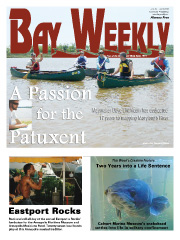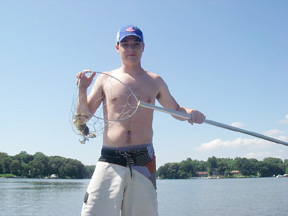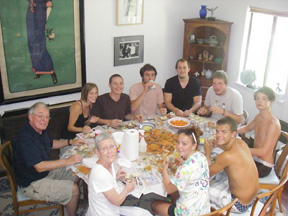Chesapeake Bay's Independent Newspaper ~ Since 1993
1629 Forest Drive, Annapolis, MD 21403 ~ 410-626-9888
Volume xviii, Issue 25 ~ June 24 to June 30, 2010
Home \\ Correspondence \\ from the Editor \\ Submit a Letter \\ Classifieds \\ Contact Us
Best of the Bay \\ Dining Guide \\ Home & Garden Guide \\ Archives \\ Distribution \\ Advertising![]()


Riding the Roller Coaster
Highs and lows on the trotline
The initial run on our trotline proved a surprising success. The first four baits had jumbo crabs hanging on them, and my netter, Harrison, quickly had them rattling in our collection basket.
After that fortunate start, they continued to come, and there was scarcely need to measure any of them. All were prime Jimmies. My son and I were ecstatic. This was going to prove an easy trip.
We would quickly discover that we were wrong again.
Our trip had nearly been a casualty from the very start. We had decided to fish a distant creek where a friend had experienced some great results the week prior. He had caught really big crabs, and lots of them. Since I had rarely encountered another crabber on many past trips to that location, we had scheduled our departure time for a leisurely 6:30am.
Our plan was to start at a comfortable hour, catch a bushel or so of big crabs, be home by noon and have a delightful feast that afternoon. The plentitude of crabs this year and a couple of early, easy and delicious successes had definitely lulled me into a false sense of competency.
|
|
![]() When my son and I arrived at our spot, we found the secret creek chock-a-block with boats, trotlines and crab traps. Outside the creek, a commercial crabber had the rest of the workable area tied up. We were screwed.
When my son and I arrived at our spot, we found the secret creek chock-a-block with boats, trotlines and crab traps. Outside the creek, a commercial crabber had the rest of the workable area tied up. We were screwed.
Returning to the put-in, we pulled our boat and headed back toward home while discussing the probabilities of finding any of our local areas still available. We weren’t optimistic.
Second Chances
Arriving at the river near nine o’clock, relaunching and heading out, quite surprisingly and almost immediately we found a vacant area that had produced well for us in the past. Our poor luck had apparently reversed.
We quickly laid out our line. It was gangbusters from the start.
Then, almost as quickly, came yet another turn of events. With over a dozen big males in the basket from just our first run, we noticed missing baits, lots of missing baits. There were gaps of 60 and 70 feet without a chicken neck left on the line. I was baffled.
Then my son blurted out, “Whoa! Look at that monster!”
And he wasn’t talking about a big crab. Just off of our bow a dark, reptilian head the diameter of a dock piling broke the surface. Behind that head, we could make out the dark shape of a very large turtle shell.
A hungry snapper that has found your crab line can spell serious difficulty if it eats up too many of your baits. This guy had a good start. As we continued down the line, we discovered there had to be more than one of the nasty reptiles working us over. Almost half our baits had disappeared, and the turtles seemed to be running off the crabs on the remaining necks as well.
Fortunately, I had purchased many more chicken necks than I needed for baiting our line. Stoically and methodically, we replaced the missing baits as we worked the trotline.
Eventually the turtles, perhaps tiring of our efforts at chasing them off or, more likely, having sated their appetites with about six pounds of fresh chicken, exited the scene.
Our previously excellent rate of harvest finally resumed.
By noon, with a bushel and a half of some seriously nice crabs — and right on schedule — we pulled our gear and headed home.
Later that day our family and some friends of my sons — they miraculously materialized just as the crabs came out of the cooker — sat down to enjoy the Bay’s largesse.
Reprising his netting skills, Harrison toasted the table: “Got ’em all in two hours this morning, no problem. Enjoy!” Then, looking over, he gave me a wink. The details of our wild ride that morning could wait. Besides no one was interested in conversation right then.
Fish Are Biting
Live-lining is definitely the way to go if you want to tangle with a nice rockfish on light tackle. The only problem with this approach is an old one, trying to get the right sized baitfish. Norfolk spot are finally here, but they are scattered, and it is difficult to find them in the small sizes that rockfish prefer. The key to reliable live-lining is catching your baitfish the day before your rockfishing trip and keeping them frisky with a good aerated bait well or holding pen. Rock will also take small perch, but they much prefer the soft-rayed spot. Deep jigging (vertical jigging) is beginning to take stripers now, and anglers using Stingsilvers and similar jigs in chrome, pink or chartreuse are scoring nice fish out of suspended schools.
Bluefish are scattered around the Bay, providing good sport and not yet proving a nuisance to anglers pursuing stripers. But the cow-nosed rays definitely are. The rays are also ruining the crabbing in some areas, swimming along trotlines and gobbling up any crustacean bold enough to hang on to the chicken necks too long. Croaker numbers are holding up, and the size of the average fish is getting better, with reports of 16 inches and bigger. Overall crabbing remains fantastic despite the rays and appears determined to hold steady.
© COPYRIGHT 2010 by New Bay Enterprises, Inc. All rights reserved.


